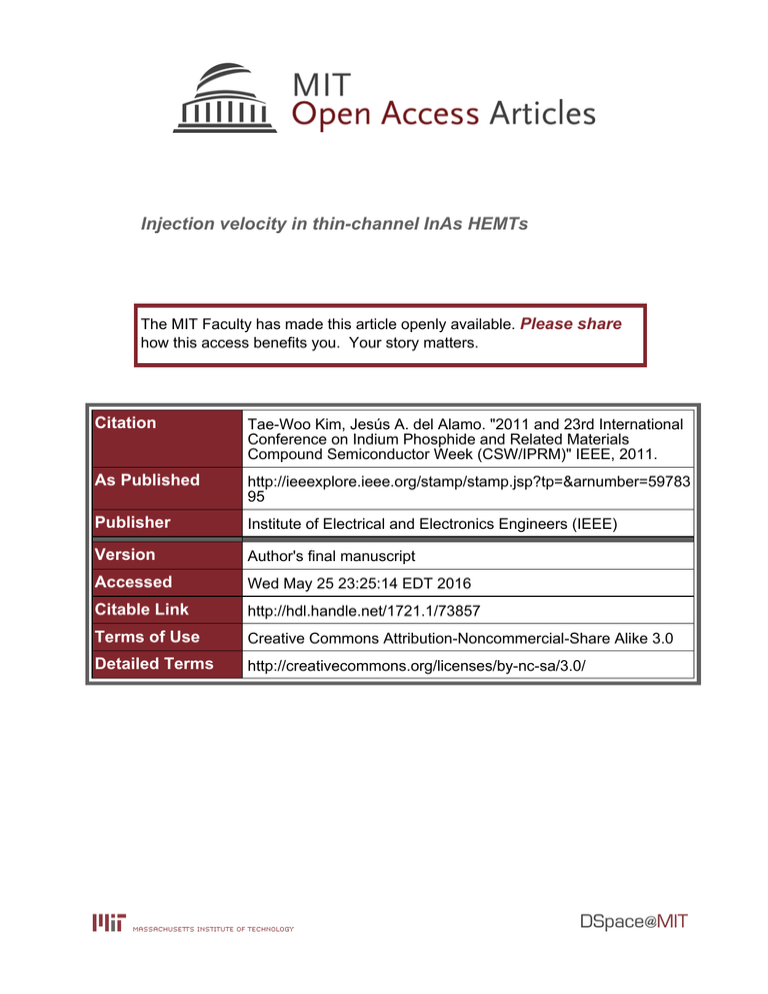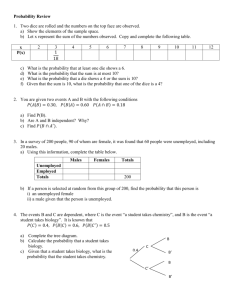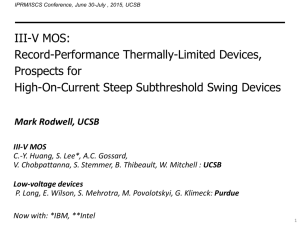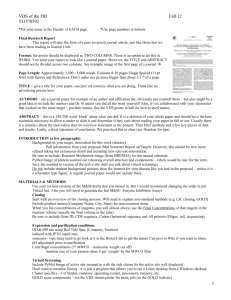Injection velocity in thin-channel InAs HEMTs Please share
advertisement

Injection velocity in thin-channel InAs HEMTs The MIT Faculty has made this article openly available. Please share how this access benefits you. Your story matters. Citation Tae-Woo Kim, Jesús A. del Alamo. "2011 and 23rd International Conference on Indium Phosphide and Related Materials Compound Semiconductor Week (CSW/IPRM)" IEEE, 2011. As Published http://ieeexplore.ieee.org/stamp/stamp.jsp?tp=&arnumber=59783 95 Publisher Institute of Electrical and Electronics Engineers (IEEE) Version Author's final manuscript Accessed Wed May 25 23:25:14 EDT 2016 Citable Link http://hdl.handle.net/1721.1/73857 Terms of Use Creative Commons Attribution-Noncommercial-Share Alike 3.0 Detailed Terms http://creativecommons.org/licenses/by-nc-sa/3.0/ Injection Velocity in Thin-Channel InAs HEMTs Tae-Woo Kim and Jesús A. del Alamo Microsystems Technology Laboratories (MTL), Massachusetts Institute of Technology (MIT), Cambridge, MA 02139, USA, E-mail: twkim78@mit.edu Abstract We have experimentally extracted the virtual-source electron injection velocity in InAs HEMTs with a 5 nm thick channel. For long gate lengths, these devices exhibit noticeably worse injection velocity than thicker channel devices of a similar design. However, for very short gate lengths, as the devices approach the ballistic regime, the extracted injection velocity becomes rather independent of channel thickness. From these results, we can conclude that InAs-based QW-FETs with very thin channels have the potential of scaling to very short dimensions. INTRODUCTION As conventional Si CMOS scaling approaches the end of the roadmap, III-V based MOSFETs are seriously being considered as an alternative technology to continue Moore’s law [1-2]. In the quest to map the potential of III-Vs for future CMOS applications, the High Electron Mobility Transistor (HEMT) has emerged as a valuable model system to understand relevant physics issues. Recently, the outstanding logic and high frequency characteristics of nanometer-scale InAs HEMTs have revealed the unique promise of this channel material for future quantum-well (QW) MOSFETs [3]-[5]. Scalability to 10 nm gate lengths, as needed in a future IIIV CMOS technology, will require the use of an extremely thin channel, tch. As channel thickness scales down, carrier transport in the channel deteriorates, mainly as a consequence of increased carrier scattering [6]. This is a serious concern. Recently, we demonstrated InAs HEMTs with tch = 5 nm that exhibit excellent logic and high frequency performance and scalability down to 40 nm gate lengths [7]. These devices allow us to examine the impact of channel thickness scaling on the transport figure of merit that matters most for logic. This is the injection velocity at the virtual source, vinj [8]. It is vinj that determines the transistor drain current and its switching speed. In this work, we have performed a rigorous extraction of the injection velocity in InAs HEMTs with a 5 nm thick channel and compared it with similar measurements on thicker channel (tch = 10 nm) devices [9]. Our results indicate that while the electron mobility degrades as the channel is thinned down, the injection velocity in very short devices is little affected. Our findings suggest that ultra-thin InAs channel QW-FETs have the potential of scaling down to very short dimensions. Fig. 1 Schematic diagram of thin-channel InAs HEMT [7]. The heterostructure features a 5 nm total channel thickness that includes a 2 nm InAs core channel layer. DEVICE TECHNOLOGY Fig. 1 shows a schematic cross sectional view of the devices studied in this work. The device heterostructure and the fabrication process were described in [7]. In essence, the channel consists of a multilayer structure with a 2 nm thick pure InAs core surrounded by a 1 nm In0.7Ga0.3As top cladding and a 2 nm In0.7Ga0.3As bottom cladding layer. In an epi wafer with an identical heterostructure except for a simpler 10 nm InGaAs capping layer with 1x1018 /cm3 Si doping, the Hall mobility and carrier density were 9,950 cm2/V-s and 2.5 x 1012 /cm3, respectively. This mobility is about 30% lower than the value obtained in a 10 nm thick channel InAs HEMT heterostructure with a 5 nm InAs core [9]. This is a manifestation of the increased carrier scattering that comes with channel thickness scaling [6]. In addition to the devices demonstrated in [7] featuring an InAlAs barrier thickness of 7 nm (measured by TEM), we have separately fabricated a new batch of devices with a thinner barrier estimated to be tins = 3 nm. The measured transconductance (gm) for devices with Lg = 40 nm is 1.6 S/mm for tins = 3 nm and 1.75 S/mm for tins=7 nm at VDS = 0.5 V. Also, the extracted Rs for tins = 3 nm is 0.275 Ohm-mm in contrast with 0.255 Ohm-mm for tins = 7 nm. Fig. 2 shows typical subthreshold characteristics of Lg = 40 nm HEMTs of both types. The two devices exhibit excellent behavior, but as expected, the thinner insulator device shows distinct advantages. The tins = 3 nm device is enhacementmode with VT = 0.11 V defined at ID = 1 mA/mm. A subthreshold swing of 65 and DIBL of 50 mV/V have been obtained in the tins = 3 nm device. For the tins = 7 nm device, these figures are 71 mV/dec and 65 mV/V, respectively. These are excellent results at this gate length. For the microwave characteristics, values of fT = 465 and fmax = 315 GHz have been obtained for the tins = 3 nm at VDS=0.5 V while values of fT = 432 GHz and fmax = 337 GHz were obtained for the tins = 7 nm at VDS = 0.5 V. INJECTION VELOCITY The normalized drain current (ID) in an FET in saturation is given by the product of the areal charge density (Qi_xo) and the electron velocity at the top of the energy barrier in the channel near the source [8]. This is the so called “virtual source”, vinj. To extract the injection velocity, we follow the methodology described in [9]. In essence, we start by estimating Qi_xo and then inj is obtained from vinj = ID/Qi_xo. The first step is to obtain the total gate capacitance, Cg = Cgs + Cgd, from high frequency S-parameter measurements at various VGS values and at VDS = 10 mV. Next, we remove the parasitic portion of Cg by subtracting Cg (VGSi - VT = - 0.2 V). We do this in devices with different gate lengths, as shown in Fig. 3 for the tins=3 nm devices. From this, by plotting Cg – Cg(VGSi – VT = - 0.2 V) vs Lg at a fixed gate overdrive, we extract the intrinsic capacitance per unit area, Cgi. The slope of the linear dependence is Cgi. This is shown in Fig. 4. By integration, we obtain Qi_xo. Both are shown in Fig. 5 for the tins = 3 nm devices. This procedure requires the measurement of Rs and Rd. From I-V measurements, we separately extract the intrinsic transfer characteristics at VDS = 0.5 V. Fig. 6 shows ID as a function of intrinsic gate overdrive for tins = 3 nm devices. From the ratio of current to charge and after appropriately correcting for DIBL [9], we can finally extract the injection velocity. Fig. 7 shows the extracted vinj against VGSi - VT for tins = 3 nm devices with Lg from 40 nm to 200 nm at VDS = 0.5 V. We observe a general increase of vinj as Lg is decreased suggesting the existence of some scattering in this gate length regime. At Lg = 40 nm, the peak injection velocity is 3.3 x 107 cm/s. 0.01 1E-3 VDS = 0.5 V Lg = 40 nm tins = 7 nm 3000 ID [A/m] 1E-5 VDS = 50 mV 1E-6 1E-7 1E-8 1E-9 -0.8 tins = 3 nm -0.6 -0.4 -0.2 0.0 0.2 0.4 0.6 VGS [V] Fig. 2 Subthreshold characteristics of Lg = 40 nm InAs HEMTs with 3 nm and 7 nm insulator thickness and tch = 5 nm. Cg-Cg(Vgsi-VT=-0.2 V)[fF/mm] tins = 3 nm 1E-4 2500 Lg = 200 nm 2000 Lg = 150 nm 1500 Lg = 100 nm Lg = 70 nm 1000 Lg = 40 nm 500 0 -0.2 0.0 0.2 0.4 0.6 VGSi-VT [V] Fig. 3 Measured gate capacitance (Cg) as a function of gate overdrive (VGSi – VT) for tins = 3 nm InAs HEMTs at VDS = 10 mV. 3000 VGSi - VT = 0.5 V 0.7 Lg = 40 nm 0.6 VGSi - VT = 0.2 V 2500 Lg = 70 nm VGSi - VT = 0.1 V Lg = 100 nm 0.5 2000 Lg = 150 nm Slope = Cgi ID [mA/m] Cg - Cg (VGSi - VT = -0.2 V) [fF/mm] VGSi - VT = 0.3 V 1500 COV_inner 1000 Lg = 200 nm 0.4 0.3 0.2 VDS = 10 mV 500 tins = 3 nm VDS = 0.5 V 0.1 0.0 -0.1 0 0 50 100 150 200 250 0.0 0.1 Lg [nm] Fig. 4 Gate capacitance (Cg – Cg (VGSi – VT = - 0.2 V)) as a function of Lg for different values of gate overdrive at VDS = 10 mV for tins = 3 nm. x 107 tins = 3 nm 14 tins = 7 nm 6 0.4 0.5 8 6 2 0.2 0.3 0.4 0 0.5 VGSi - VT [V] 2 2 4 Fig. 10 summarizes the peak velocities as a function of Lg obtained at VDS = 0.5 V and compares them with results obtained in [9] for thicker channel InAs HEMTs with tins = 4 nm. For long gate lengths, the InAs thin channel devices exhibit significantly worse injection velocity than the thicker channel InAs devices of about the same tins [9]. This is a consequence of the increased scattering as manifested in the reduced mobility. However, for very short gate lengths and for devices with about the same barrier thickness, as the devices become nearly fully ballistic, their injection velocities converge regardles of mobility. This is to be expected since for short enough devices, electron velocity reflects the band structure and is less affected by scattering. This results are important because they suggest that very thin channel device designs offer the potential of scaling to very short dimensions without degradation in their transport characteristics. 4 Fig. 5 Extracted intrinsic gate capacitance Cgi as a function of VGSi – VT at VDS = 10 mV for tins=3 nm and 7 nm devices. The integral of Cgi provides Qi_xo. tins = 3 nm 3 7 Fig. 8 shows similar data for devices with tins = 7 nm. The general trends are similar with the peak vinj being 2.8 x 107 cm/s. The decrease in injection velocity for a thicker barrier design is probably a consequence of a lower electron concentration and worse short-channel effects which are known to impact the velocity. This is also consistent with fT measurements. Fig. 9 shows extracted injection velocity against VGSi – VT at different values of VDS for a 40 nm device with tins = 7 nm. We observe a general decrease of vinj as VDS decreases or VGSi – VT increases beyond a certain point as the device enters the linear regime. Lg = 40 nm vinj [10 cm/s] 2 4 QI_xo [C/cm ] Cgi [fF/m ] 10 0.1 0.3 Fig. 6 Typical transfer characteristics for tins = 3 nm HEMTs of different gate lengths as a function of gate overdrive at VDS = 0.5 V. 12 0 -0.4 -0.3 -0.2 -0.1 0.0 0.2 VGSi - VT [V] Lg = 70 nm Lg = 100 nm Lg = 150 nm 2 Lg = 200 nm 1 0 0.0 0.1 0.2 0.3 0.4 VGSi - VT[v] Fig. 7 Extracted vinj as a function of VGSi–VT for devices with different values of Lg for tins = 3 nm at VDS = 0.5 V. 3.5 REFERENCES Lg = 40 nm 3.0 [1] R. Chau et al., IEEE Trans. Nanotech., Vol. 4, p. 153, 2005. [2] D.-H. Kim et al., IEEE TED, Vol. 55, p. 2546, 2008. [3] M. Radosavljevic, et al., IEDM, p. 319, 2009. [4] D.-H. Kim et al., IEDM, p. 146, 2008. [5] D.-H. Kim et al., EDL, Vol. 31, p. 806, 2010 [6] G. Meneghesso et al., IEEE TED, Vol. 46, p. 2, 1999. [7] T.-W. Kim et al., IPRM, p. 496, 2010. [8] D.A. Antoniadis et al., IBM J. Res. & Dev., Vol. 50, p. 363, 2006. [9] D.-H. Kim et al., IEDM, p. 861, 2009. Lg = 80 nm 2.0 Lg = 150 nm 7 vinj [10 cm/s] 2.5 1.5 Lg = 200 nm 1.0 0.5 tins = 7 nm, VDS = 0.5 V 0.0 0.0 0.1 0.2 0.3 0.4 0.5 VGSi- VT [V] Fig. 8 Extracted vinj as a function of VGSi – VT for devices with different values of Lg for tins = 7 nm devices at VDS = 0.5 V. 4.0 ACKNOWLEDGEMENTS This work was sponsored by Intel Corporation and FCRPMSD at MIT. Device fabrication took place at the facilities of the Microsystems Technology Laboratories (MTL), the Scanning Electron Beam Lithography (SEBL) and the NanoStructures Laboratory (NSL) at MIT. Authors would like to thank to Dr. Dae-Hyun Kim for useful discussions. tins = 7 nm, Lg = 40 nm 3.5 2 VDS = 0.4 V 2.0 3 1.5 0.5 VDS = 0.1 V 0.1 0.2 0.3 0.4 tins = 4 nm tins = 7 nm 2 n ~ 9,950 cm /V-s 2 7 VDS = 0.3 V 1.0 0.0 0.0 n ~ 13,000 cm /V-s tins = 3 nm 2.5 vinj [10 cm/s] 7 vinj [10 cm/s] 4 VDS = 0.5 V 3.0 Strain-Si 1 0.5 VGSi - VT[V] Fig. 9 Extracted vinj as a function of VGSi – VT for a device with Lg = 40 nm and tins = 7 nm, at different values of VDS. Si nFETs (VDS = 1.1 ~ 1.3 V) VDS = 0.5 V 0 10 100 Lg [nm] CONCLUSION We have performed a rigorous extraction of the Fig. 10 Extracted vinj vs. Lg for various InAs HEMTs with different channel and barrier thickness at VDS = 0.5 V, injection velocity in thin-channel InAs HEMTs. together with those of advanced Si nFETs at VDS = 1.1 ~1.3 V. Although the electron mobility degrades in thin channels, the injection velocity does so much less. In a Lg = 40 nm gate HEMT with a 5 nm thin InAs channel, we have measured an injection velocity of 3.3 x 107 cm/s. This works suggest that InAs-based thin channel QW-FETs have the potential of scaling to very short dimensions.








